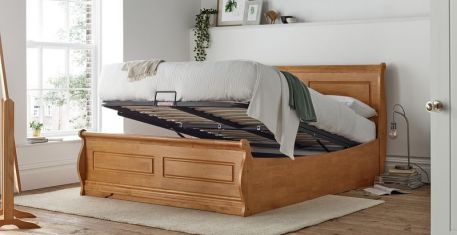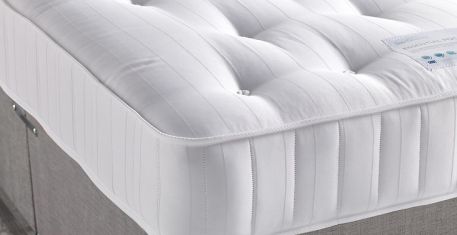
Back pain can have a serious impact on many aspects of your life, but by choosing the right mattress for you, you can at least help yourself to get a great night's sleep. Resting comfortably is a vital part of getting better, and will help you to tackle the day ahead.
How can a bad back affect sleep?

Lower back pain, also known as lumbago, affects around two in five people at some point in their lives. It can simply be caused by strain on the muscles and joints of the back, or it may be due to a more serious problem like a slipped disc, sciatica or injuries such as whiplash.
In some cases it will go away by itself within a few days or weeks, but if it lasts for longer the pain and discomfort can begin to have a serious impact on your sleep. To understand why take a look at the three natural curves of the spine:
The cervical spine at the top curves outwards to support the head. The thoracic spine in the middle curves inwards to support the upper body. Finally, the lumbar spine at the bottom curves back outwards again to support the back.
Ideally, these three curves should be maintained at all times – when you're up and about, when you're sitting down, and for the eight hours a night you ideally spend in bed.
What causes back pain?
You may experience back pain for a number of reasons, quite often there is no specific reason for the pain to occur and this type of back pain is often the result various lifestyle factors, such as:
- Poor posture when sitting at a desk or standing
- Not having the correct back support when sitting
- A pulled muscle or strain
- Sleeping on a mattress that does not provide sufficient spinal support
What sleeping positions are best for a bad back?

You might find that your normal sleeping position is too uncomfortable, so try different positions.
For side sleepers: Sleeping on your side, with your knees drawn up, can help to alleviate pressure on your spine. Try using a thicker pillow than you usually have if you feel like your head isn't getting enough support.
For back sleepers: If it's more comfortable to sleep on your back, try placing a pillow underneath your knees, which will help to keep your spine correctly aligned.
For front sleepers: Sleeping on your front is not generally a good idea if you have back pain. It can flatten the natural curve of the spine, placing unwanted strain on your back muscles. It also means your neck is rotated, which can exacerbate pain between the shoulders.
What are the best mattresses for bad backs?
Although there's a perception that people with bad backs are more comfortable on firmer mattresses, in reality, it depends on the individual. A 2003 study in the medical journal the Lancet suggested that a medium-firm mattress provides the best results for people with non-specific back pain, but if you find a softer mattress helps you to sleep comfortably, that's the right mattress for you.
It's also a good idea to replace an old mattress that you've slept on for years, as these tend to develop sags in the spots where you sleep. Even small sags of half an inch mean your mattress isn't providing optimum support, and sags an inch deep or more mean your spine isn't being correctly supported.
With that in mind, it's best to visit a mattress store and "test drive" a number of different ones for yourself. Get into your favoured sleeping position, and don't be shy of taking a good few minutes with each one to really make up your mind!
Are memory foam or pocket sprung mattresses best for a bad back?
You might wish to start your search with memory foam and latex mattresses. According to research by the independent sleep website Sleep Like the Dead, these are some of the best mattresses for people who live with back, hip and shoulder pain, because they give plenty of support and they're less likely to sag.
Memory foam, in particular, has high "conformability", meaning the mattress moulds to the specific shape of your body – that's exactly what memory foam's for, after all. This can be a particular benefit for people suffering from pain in their lower backs.
One of the benefits of the more traditional pocket sprung mattresses is that they provide very effective weight distribution which is great for taller or heavier individuals.
Can air mattresses help a bad back?
Air beds aren't just for camping! It might be tempting to assume that the more you spend on a quality mattress, the more it'll do for your back pain – but in fact, some people find an inexpensive air mattress best of all.
One of the greatest benefits of an air mattress is that by adjusting the level of inflation, you can increase or decrease the firmness and support it provides to your liking. It might not be a solution for everybody, but if you're finding traditional mattresses aren't doing the job, an air mattress (or alternatively a water bed) is certainly worth a try.
To summarise:
- Choose a mattress that allows you to sleep comfortably
- Replace a mattress every 8 years. Sags mean the mattress is not providing optimal support
- Don't be scared to "Test Drive" different mattresses before you buy
- Consider memory foam mattresses especially if you have lower back pain
Our pick of the best mattresses for bad backs
- Best for lower back pain: Sleep Sanctuary Ortho 2000 Gel Memory Mattress
- Best for upper and middle back pain: Europa Ortho Luxury 1000 Pocket Sprung Mattress
- Best for a firm mattress with a high spring count: Sleep Sanctuary Crystal 3000 Pocket Sprung Mattress
- Best orthopaedic mattress at a lower cost: Somerset Ortho Sprung Mattress



